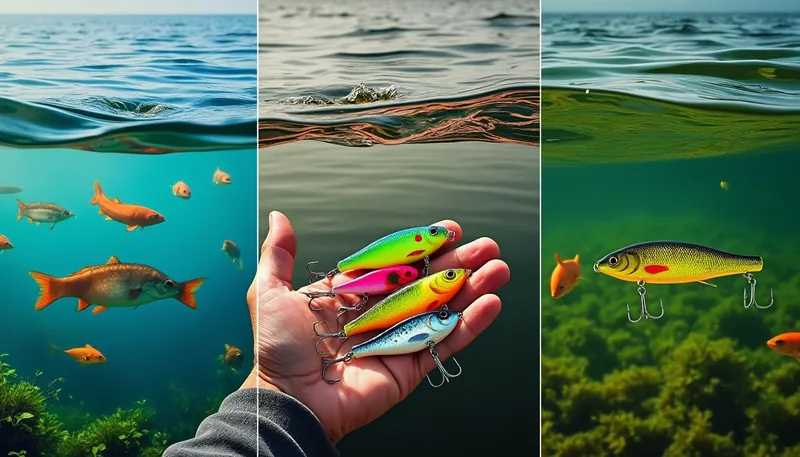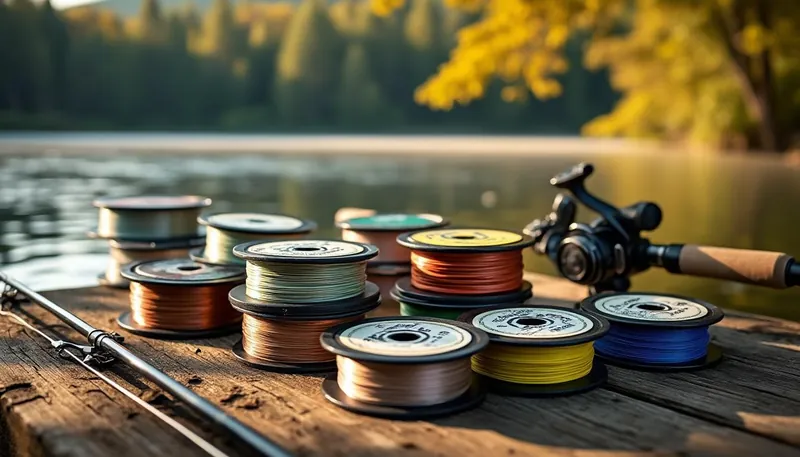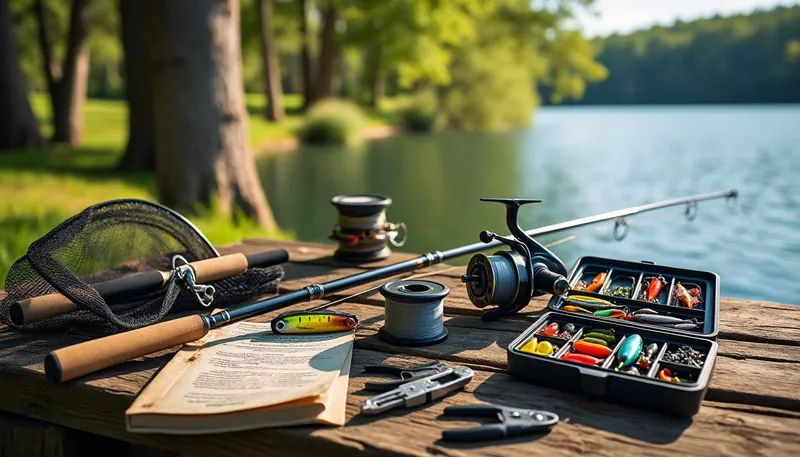Choosing the right lure color is crucial for every angler looking to increase their catch rate. When you’re at the water’s edge, a myriad of colors beckons from your tackle box, but which one will entice the fish today? Factors like water clarity, light conditions, and the local fish species all come into play. Understanding how to navigate these considerations can elevate your fishing game from mundane to triumphant. This guide will explore the interplay of color and conditions and equip you with the knowledge to pick the perfect lure, making your next fishing trip a success.
In brief:
- 🎣 Different water conditions call for tailored lure colors to maximize effectiveness.
- 🌊 Clear waters benefit from natural hues, while stained conditions favor bright, bold colors.
- 💡 The time of day impacts visibility and color choice, affecting fish behavior.
- 🌟 Seasonal patterns influence feeding habits, thereby shaping color selection.
- 🧳 A versatile tackle box containing varied colors will prepare you for any fishing endeavor.
Understanding the Importance of Lure Color in Fishing
When fishing, the color of your lure is more than just eye candy; it’s a strategic decision that can make or break your outing. Fish have a unique way of perceiving colors, relying on their vision to identify prey. This perception varies significantly across different species. For example, a bass may react positively to a vibrant lure while a trout may prefer more muted tones. Understanding these nuances can drastically improve your chances.
Factors that influence color effectiveness include:
- 👁️ Visual Perception of Fish: Fish possess photoreceptors in their eyes, enabling them to see a range of colors, some even into the ultraviolet spectrum. The ability to see different wavelengths influences their response to particular lure colors.
- 🌍 Environmental Influences: Factors like light penetration, water clarity, and the presence of natural forage greatly impact how fish perceive lure colors. For instance, in murky waters, subtle colors might get lost, while bright and bold colors can shine.
- 🧠 Psychological Factors: It’s not just the fish that are influenced by color. An angler’s confidence in their lure choice can directly affect their presentation style, leading to success. If you feel good about what you’re throwing, you may fish it with more conviction.
| Color Perception Factor | Description |
|---|---|
| Visual Perception | Fish can see a wide range of colors, but their preferences vary by species. |
| Environmental Influences | Light conditions and water clarity affect how colors are perceived. |
| Psychological Factors | Angler confidence can impact fishing success based on lure choice. |
Analyzing Water Clarity for Lure Color Selection
Water clarity is one of the primary considerations when choosing your lure color. It affects visibility and thus greatly influences which colors may work best. There are typically three categories to consider: clear water, stained water, and muddy water, each calling for different strategies.
Clear Water Strategies
In clear water conditions, fish can see details from a distance. This is where natural colors that mimic local baitfish become particularly effective. Subtle hues, including:
- 🌊 White: A classic choice, mimicking the belly of baitfish.
- 🦐 Light Gray: Blends well while remaining visible to fish.
- 🌼 Soft Pastels: Such as light pink or pale yellow, which can be enticing without overwhelming fish.
These colors tend to work best as they are less intrusive and often look natural.
Stained Water Techniques
When the water is stained or murky, it becomes less transparent, and the fish’s ability to see diminishes. In these scenarios, brighter, high-visibility colors should be employed to attract attention, including:
- ⚡ Chartreuse: Often a go-to color for murky conditions.
- 🟠 Bright Orange: Stands out well and grabs attention.
- 🌈 Neon Colors: Fun and flashy, these are perfect when fish are actively feeding.
Muddy Water Considerations
In muddy waters, where clarity is heavily compromised, offering contrasting colors becomes essential. Fish rely on silhouettes and movement to detect lures in this environment. Good choices are:
- 🖤 Black and Chartreuse: This combination gives a strong silhouette against murky backgrounds.
- 💙 Dark Blue with Bright Tails: Ideal for creating an eye-catching contrast.
- 🔥 Fire Tiger Patterns: Striking and effective for drawing attention.
| Water Clarity Type | Recommended Lure Colors |
|---|---|
| Clear Water | White, Light Gray, Soft Pastels |
| Stained Water | Chartreuse, Bright Orange, Neon Colors |
| Muddy Water | Black and Chartreuse, Dark Blue with Bright Tails, Fire Tiger Patterns |
Evaluating the Role of Color Tones in Lure Selection
Colors can be grouped into light, bright, and dark tones, each serving a distinct purpose based on environmental conditions.
Light Colors
Light colors tend to be more versatile and effective in clear water. They mimic natural prey effectively, offering a subtle approach. Popular choices for light colors include:
- ⚪ Off-White: Mimics the bellies of baitfish.
- 🕊️ Pastel Tones: Soft blues, pinks, and yellows appeal without being overly aggressive.
Bright Colors
Bright colors command attention and should ideally be utilized in stained waters. Notable bright colors include:
- 💚 Chartreuse: A classic choice that stands out well.
- 🌈 Neon Colors: Great for when fish are actively feeding, as they are often perceived as irresistible.
Dark Colors
The power of dark colors shines in low-light conditions, offering strong silhouettes visible to fish. Key choices include:
- ⚫ Black: A mainstay for night fishing and deep waters.
- 🔵 Dark Blues and Purples: Ideal for replicating natural prey in dim environments.
| Color Tone | Best For | Examples |
|---|---|---|
| Light Colors | Clear Water | Off-White, Pastel Tones |
| Bright Colors | Stained Water | Chartreuse, Neon Colors |
| Dark Colors | Low-Light Conditions | Black, Dark Blues and Purples |
Seasonal Adjustments for Optimal Lure Color
Seasonal changes greatly impact fish behavior, feeding patterns, and subsequently, the effectiveness of lure color selection. Each season unveils unique strategies for anglers to consider.
Spring Strategies
As the weather warms in spring, fish prepare for spawning, often exhibiting more aggressive feeding behaviors. Bright colors can trigger strikes when fish are actively looking for food. Utilize vibrant colors in slightly murky waters due to spring rains.
Summer Tactics
During the hot summer months, fish may retreat to deeper and cooler waters. Lighter colors excel in clear water, while more vibrant colors can be effective in shallower environments during peak feeding times.
Fall Techniques
As cooler temperatures arrive, fish ramp up their feeding in preparation for winter. Natural colors that mimic the local baitfish become effective, such as shades resembling shad or bluegill.
Winter Adaptations
In winter, fish become less active, requiring strategic color choices. In clear water, muted colors like whites or light blues can work, while in stained waters, dark colors that provide strong silhouettes will help in attracting fish.
| Season | Recommended Lure Colors |
|---|---|
| Spring | Bright Colors (e.g., Chartreuse, Pink) |
| Summer | Lighter Colors (e.g., Whites, Pale Blue) |
| Fall | Natural Colors (e.g., Shad Patterns, Bluegill) |
| Winter | Muted Colors (e.g., Light Blue, Dark Patterns) |
Creating a Versatile Tackle Box for All Conditions
A well-curated tackle box is a critical element in successful fishing trips. To prepare for any given condition, incorporate a variety of colors that can handle different scenarios.
Building Your Basic Color Palette
Start with a core palette of colors that cover various water conditions:
- 🔲 Natural Colors: Include hues like white, gray, and light blue for clear water.
- 🌟 Bright Colors: Keep chartreuse and orange handy for stained waters.
- 🌚 Dark Colors: Black and dark blue are essentials for both night fishing and murky water conditions.
Diverse Lure Selection
Invest in a variety of lure types to cater to different fishing styles and conditions:
- 🪝 Crankbaits: Great for covering lots of water in different colors and patterns.
- 🦠 Soft Plastics: Such as Zoom worms or Yamamoto lizards that can be switched based on preferences.
- 🌀 Spinnerbaits: Adding interchangeable skirts can be beneficial for adapting colors to varying conditions.
| Tackle Box Essentials | Purpose |
|---|---|
| Natural Colors | Effective in Clear Water |
| Bright Colors | Best in Stained Water |
| Dark Colors | Key for Night and Murky Conditions |
| Variety of Lure Types | Covers Different Fishing Techniques |
What lure colors work best for clear water?
In clear water, natural colors like light blues, whites, and translucent shades are most effective.
How do I select color for stained water?
Bright colors such as chartreuse, orange, and neon hues are ideal for stained water, helping fish see the lure better.
Does the time of day affect lure color choice?
Absolutely! Dark colors are best during low-light conditions, while brighter colors work well in daytime.
What should be included in my tackle box?
Ensure to have a mix of natural, bright, and dark colors along with various lure types to handle different fishing scenarios.
How can I build confidence in my lure choices?
Experiment with different colors and keep track of their effectiveness in various conditions to refine your selections.


